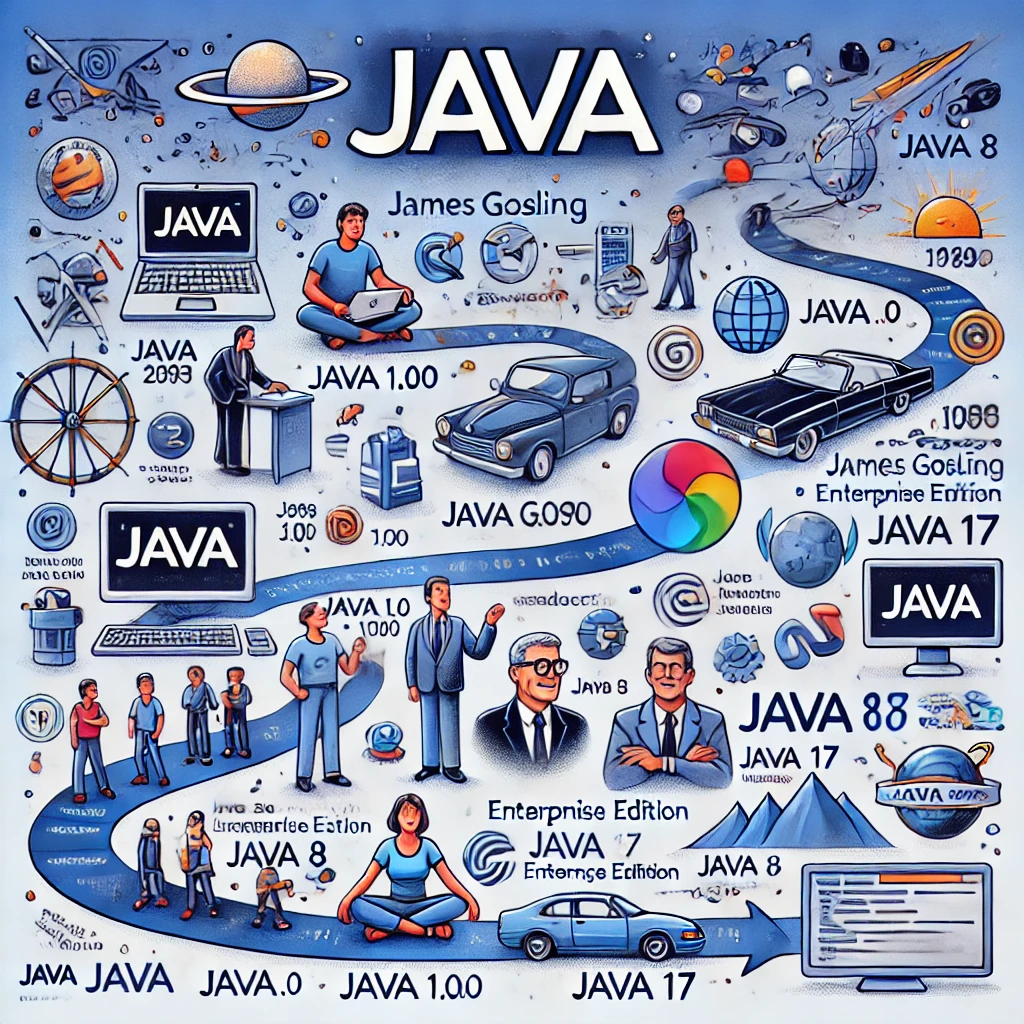History of Java programming language

| Year of issue | Name of packet | Version |
| 1996 | JDK 1.0 | Oak |
| 1997 | JDK 1.1 | Java |
| 1997 | J2SE 1.2 | Java 2 |
| 2000 | J2SE 1.3 | Java 2 |
| 2002 | J2SE 1.4 | Java 2 |
| 2004 | J2SE 5.0 | Java 5 |
| 2006 | Java SE 6 | Java 6 |
| 2011 | Java SE 7 | Java 7 |
| 2014 | Java SE 8 | Java 8 |
| 2017 | Java SE 9 | Java 9 |
| 2018 | Java SE 10 | Java 10 |
| 2018 | Java SE 11 | Java 11 |
| 2019 | Java SE 12 | Java 12 |
| 2019 | Java SE 13 | Java 13 |
| 2020 | Java SE 14 | Java 14 |
| 2020 | Java SE 15 | Java 15 |
| 2021 | Java SE 16 | Java 16 |
| 2021 | Java SE 17 | Java 17 |
| 2022 | Java SE 18 | Java 18 |
| 2022 | Java SE 19 | Java 19 |
| 2023 | Java SE 20 | Java 20 |
| 2023 | Java SE 21 | Java 21 |
| 2024 | Java SE 22 | Java 22 |
| 2024 | Java SE 23 | Java 23 |
| 2025 | Java SE 24 | Java 24 |
| 2025 | Java SE 25 | Java 25 |
JDK 1.0
In 1996, the fascinating story of a programming language began—a language originally named Oak. The first steps of Java were taken, marking the birth of a young technology. The creators of the language are considered to be James Gosling, Patrick Naughton, and Bill Joy. Java was developed based on the popular C++ language of the time.
JDK 1.1
In 1997, JDK 1.1, the first official version of the language under the name Java, was released. This moment became significant in its history, marking the beginning of an era filled with innovation and continuous development.
There are several versions regarding the origin of the language's name. The first suggests that it was named after the Java coffee brand, which, in turn, was named after the island of Java. This is why we see a coffee cup on the Java logo. The second version connects the name with a coffee machine, one of the household devices for which the language was initially designed to program.
J2SE 1.2
The next version of Java was also released in 1997, and the package name was changed from JDK (Java Development Kit) to J2SE (Java 2 Standard Edition). The language line was called Java 2.
J2SE 1.3 and J2SE 1.4
In 2000 and 2002, the third and fourth versions of Java were released, but the language line retained the name Java 2. This name became so entrenched that many books were published with "Java 2" in the title, even though they actually described subsequent versions of Java. For example, the book by Blinov and Romanchik, "Java 2: A Practical Guide," was based on Java 5. Similarly, Horstmann's book "Java 2: Fundamentals" was released with Java SE 6.
J2SE 5.0
With the release of Java 5, marketers decided to change the name, and the language line became Java 5, while the package name changed to J2SE 5.0. Since then, each subsequent version has followed the name of its package, including Java 6, Java 7, and Java 8. The fifth version of Java introduced a significant number of changes:
- enums,
- annotations,
- generics,
- varargs,
- for each,
- JavaDoc
- autoboxing and unboxing.
Java SE 6
In the sixth version of Java, the main changes focused on collections—new interfaces such as NavigableSet and NavigableMap were added. Additionally, the package name was slightly modified again to Java SE 6, which stands for Java Standard Edition.
Java SE 7
In the seventh version of Java, several new features were introduced, including:
- the use of the String class in switch statements,
- multicatch exception,
- try-with-resources,
- underscores in numeric literals,
- the use of binary literals.
There was a five-year gap between the release of the sixth and seventh versions. This delay was likely due to the acquisition of Sun Microsystems, which owned Java, by Oracle in 2009. Of course, this was not the best time for Java developers, as other languages, particularly Kotlin, which was based on Java, began to gain significant traction.
Java SE 8
The eighth version of Java was also very significant. It introduced new features such as lambda expressions, along with method and constructor references, and functional interfaces. Similar constructs had already appeared in other languages, so their arrival in Java was highly anticipated. Additionally, static methods were added to interfaces, as well as the `default` keyword, a new API for date handling, and the Stream API for working with collections.
Java SE 9
In the ninth version of Java, private methods were added to interfaces, a modular system was introduced, and several improvements were made to the Stream API.
Java SE 10
In the tenth version of Java, the `var` keyword was introduced. From this point on, it was decided to release two versions each year, with one version coming out in September and the other in March.
The subsequent versions—Java SE 11, Java SE 12, Java SE 13, Java SE 14, Java SE 15, Java SE 16, Java SE 17, Java SE 18, Java SE 19, Java SE 20, Java SE 21, Java SE 22 and Java SE 23—continue to enhance the capabilities of the language by introducing new ideas and technologies.
Please log in or register to have a possibility to add comment.